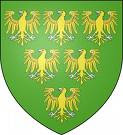There were no new non-fiction books on Edward II in
2013. And the discovery of Richard III’s
remains meant that for once the huge influx of books on the Tudors was seriously
challenged by the White Rose. As usual,
my best books list includes very little historical fiction. Despite there being a few novels featuring
Isabella, wife of Edward II, I wouldn’t recommend any of them. The only fictional book to make my list is –
1. Towards Auramala: The mystery of King Edward II's fate by Ivan Fowler. I won’t give too much to away, suffice to say
it gives an interesting account of the possible survival of Edward II in Italy.
2. ‘In the footsteps of Anne Boleyn’ by Sarah
Morris and Natalie Grueninger
is a must for anyone interested in Anne Boleyn but especially for those to whom
she is a serious interest. The book
plots all the known places visited by Anne Boleyn throughout her life, from the
obvious, such as Hever castle, and the less well-known Thornbury Castle. It’s a fascinating read and has some superb
pictures, some of them taken personally by the authors.
3. ‘Bosworth: The Birth of the Tudors’ by Chris
Skidmore. I bought this book at the BBC
Talk Tudor day, an event at which Chris Skidmore spoke. It gives an insightful build-up to the battle
of Bosworth and the early life of Henry VII.
Once again, the use of personal photos by the author is a welcome
addition.
4. The Woodvilles: The Wars of the Roses and England's Most Infamous
Family, by Susan Higginbotham. I was
really looking forward to reading Susan’s non-fiction book on the Woodvilles
and she didn’t disappoint! As well as
examining some of the off-repeated stories about the Woodvilles – for example,
plundering the royal treasure – I particularly enjoyed Susan’s research into
Anthony Woodville – his character and patronage.
5. The Creation of Anne Boleyn: A New Look at England's Most Notorious
Queen by Susan Bordo. Not the usual run
of the mill biography of Anne Boleyn.
Instead, Bordo takes a look at the original primary sources and the
motives of those who wrote them, and how these sources shaped the perception of
the roles allotted to Anne Boleyn throughout history. The book then looks at the portrayal of Anne
in fiction and media such as the cinema and TV.
I particularly enjoyed the interview with Natalie Dormer, who played
Anne in the recent TV series ‘The Tudors’.
6. Tudor: The Family Story by Leanda
De Lisle. Very well-written and
researched. I particularly enjoyed
reading about Margaret Beaufort.
7. OK, this is a book that should be split in
half. The King's Grave: The Search for Richard III by
Philippa Langley and Michael Jones. Undoubtedly
the discovery of the burial place and remains of Richard III has to be the
history story of the year. The part of
the book which focuses on the search for Richard’s grave is very interesting
and readable – the research of John Ashdown Hill, raising the funds for the
project, the explanation of the dig itself, the matching of the DNA. Alas, the part which deals with the history
of Richard III himself is woeful, and once again it is a defence of anything
Richard was accused of and demonising that horrid Henry – Tudor, that is. So we get the tale of poor Richard having to
endure the killing of his father and elder brother Edmund, who just might have been killed after the battle
of Wakefield, whilst the death of the Lancastrian Prince of Wales, Edward, son
of Henry VI, is given during the battle of Tewkesbury – despite there being
more than one source that says he was killed afterwards. The brutal slaying of Hastings is smoothed
over with continuous referrals to how Richard honoured him (yes, really), by allowing him to be buried in Windsor
as he requested. Richard is traumatised
by the possible rape of his mother Cecily by Lancastrian supports, but Henry
Tudor is a coward at 12 years old for fleeing the battle in which Lord Herbert,
his guardian, is captured and killed. At
the battle of Bosworth, Henry Tudor is the luckiest man ever to enter the
battlefield – the word is used repeatedly – and Henry is again accused as a
coward for hiding behind his pike-men – who luckily are using the best in
pikes! Richard isn’t reckless in his
charge towards Henry – he’s so chivalrous he believes in fighting Henry hand to
hand. I have to wonder where he learnt
this chivalry – from his brothers, Edward IV and George, Duke of Clarence? I hardly think so. Excellent role models in ruthless ambition. Even admitting that Richard more than likely
killed ‘the princes in the Tower’, does not alter the extreme bias of this part
of the book. It’s such a shame. Richard III was a man of his times – and
those times were violent. He was not the
monster of Shakespeare – although I am amazed that anyone would think
Shakespeare a historian rather than a play-write. A far more balanced book should have been
produced. Richard doesn't need another saintly defence of his character. Rather, he needs a more balanced approach and his life needs to be looked at in the context of his times.


